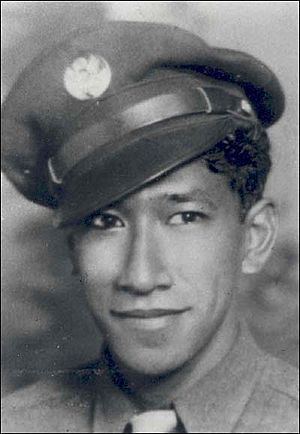David Akui facts for kids
Quick facts for kids
David M. Akui
|
|
|---|---|
 |
|
| Born | January 16, 1920 |
| Died | September 15, 1987 (aged 67) Kaneohe, Honolulu, Hawaii |
| Allegiance | |
| Service/ |
|
| Years of service | 1940–1945 |
| Rank | Master sergeant |
| Unit | Hawaii National Guard 5307th Composite Unit |
| Battles/wars | World War II |
David M. Akui was an American soldier who became famous during World War II. He is known for capturing the very first Japanese prisoner of war. This happened right after the attack on Pearl Harbor. Akui was a corporal in the Hawaii Territorial Guard at the time.
Contents
David Akui: A World War II Hero
David M. Akui was born on January 16, 1920. He was from Hawaii. He joined the United States Army on October 15, 1940. He served throughout the entire war in the Pacific Ocean area.
The Day After Pearl Harbor
On December 8, 1941, a day after the surprise attack on Pearl Harbor, Akui was walking on Waimanalo Beach in Hawaii. He was with Lieutenant Paul C. Plybon. Akui found a Japanese man lying unconscious on the beach. The man woke up to find Akui standing over him with a pistol.
Akui took the man into custody. The man was identified as Ensign Kazuo Sakamaki. Ensign Sakamaki was the commander of a special two-man midget submarine. This small submarine had taken part in the Pearl Harbor attacks.
The Midget Submarine's Journey
Ensign Sakamaki's submarine had a broken gyrocompass. This made the submarine sail in circles. It then ran aground on a reef. The United States Navy destroyer USS Helm spotted it and fired its guns. The destroyer's shots missed, but the blasts freed the submarine from the reef. Sakamaki was able to submerge his submarine again.
When he could not fix the gyrocompass, Sakamaki told Petty Officer 2nd Class Kiyoshi Inagaki to swim ashore. Sakamaki then set charges to destroy the submarine. He then left the submarine himself. Sadly, Inagaki drowned trying to swim to shore. Sakamaki made it to shore, but he passed out from being so tired. Corporal Akui found him there.
Sakamaki's demolition charges did not explode. His submarine also washed ashore. It was later saved and is now on display. You can see it at the National Museum of the Pacific War in Fredericksburg, Texas.
Fighting in Burma
Akui continued to serve through the rest of the war in the Pacific. He was a member of the famous "Merrill's Marauders" unit. This group fought against the Japanese in the jungles of Burma.
Later Life and Legacy
David Akui retired from the United States Army as a Master sergeant. He spent the rest of his life in Hawaii. He passed away in Kaneohe, Honolulu in 1987. He was 67 years old.

